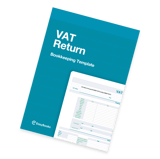A value-added tax (VAT) Return calculates how much VAT a company should pay or expect to recover, by HMRC. In most cases Vat Returns, and the accompanying payments must be made quarterly to HMRC.
When you first start your business, understanding the different taxes that may apply to you is essential. It’s not always necessary to register for VAT and it’s important that you know when/how you may be affected.
What is a VAT Return?
A completed VAT Return will either show how much is owed to HMRC or whether you’re due a refund. If the amount reclaimable is more than the VAT due on sales, HMRC will repay you the difference.
These returns differ from the annual tax returns submitted by small limited company owners, sole traders and people who are self-employed, where the tax is related to the profits that have been declared.
When you purchase items or services for your business, you may be charged VAT by your supplier. You have to keep track of every one of these VAT purchases. Then, if you sell something to your clients, you must be aware of whether the transaction is categorised as a ‘taxable supply’.
.png)
If it is, you must charge VAT on your invoice and keep accurate records of those charges.
A VAT Return summarises what you paid against when you sold. HMRC only requires you to send the summary numbers in your return, but you must also retain complete detailed records in an MTD-compatible software of the actual transactions. This is just in case HMRC should decide to open an investigation.
Once a business reaches £85,000 of taxable supplies, then they must register for VAT. A business can register voluntarily below this figure if they wish.
You can find out how to accurately calculate your VAT Return in this blog here.
How to Tell the Difference Between a Tax Return and a VAT Return
VAT is charged and recovered on transactions, both income and expenditure. This is different from your annual tax return which is based upon the declared profits of your business over your accounting year.
As mentioned before, VAT Returns are submitted to HMRC periodically, using the schedule determined at the point of registration This can be monthly, quarterly or annually and this is different from the tax paid on the profit of the company.
If you’re VAT registered when completing your annual tax return, it’s essential to use your net income figure. This is because VAT isn’t income for your business, it’s money you collect on behalf of HMRC.
For a business registered for VAT under the flat rate scheme, they must also report the loss or gain from being registered under the FRS (flat rate scheme) as part of their annual return.
VAT is a minefield and it’s pretty clear that to create and maintain accurate records for VAT, you will need some form of software to keep everything in order.
The Making Tax Digital scheme makes it much easier for businesses. One of the main goals behind introducing this new system is to reduce the amount of tax lost per year due to avoidable errors. As VAT and tax returns now need to be submitted digitally, businesses will need a software solution that is approved and accepted by HMRC.
Automate Your VAT Returns With a Simple Bookkeeping App
EasyBooks has all the functionality that you need to help you run your business in the most efficient way possible. You can see how we fare against other user-friendly bookkeeping apps here.
It automatically collects sales and purchase information and does all the calculations for you. The software keeps a continuous update of your VAT position and so as long as your records are up to date, you’ll always know where you stand. When the VAT period is over and you have reviewed the transactions to check for any errors, you connect to HMRC and submit your return online.
Making the transition to digital bookkeeping is quicker with an application in your back pocket. Download your free trial now.








